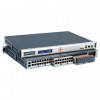Lantronix SLC 8000 Advanced Console Manager User Guide - Page 219
Host List Commands, Scripts
 |
View all Lantronix SLC 8000 Advanced Console Manager manuals
Add to My Manuals
Save this manual to your list of manuals |
Page 219 highlights
9: Device Ports Escape Sequence The escape character used to get the attention of the SSH or Telnet client. It is optional, and if not specified, Telnet and SSH use their default escape character. For Telnet, the escape character is either a single character or a two-character sequence consisting of '^' followed by one character. If the second character is '?', the DEL character is selected. Otherwise, the second character is converted to a control character and used as the escape character. For SSH, the escape character is a single character. 3. You have the following options: - To add a host to the host list, click the right arrow. The host displays in the Hosts box. - To remove a host from the host list, select the host in the Hosts box and click the left arrow. - To give the host a higher precedence, select the host in the Hosts box and click the up arrow. - To give the host a lower precedence, select the host in the Hosts box and click the down arrow. 4. Click the Edit Host List button. After the process completes, a link back to the Device Ports > Settings (1 of 2) page displays. To delete a host list: 1. Select the host list in the Host Lists table. 2. Click the Delete Host List button. After the process completes, a link back to the Device Ports > Settings (1 of 2) page displays. Host List Commands Go to Host List Commands to view CLI commands which correspond to the web page entries described above. Scripts The SLC unit supports three types of scripts: Interface Scripts which use a subset of the Expect/Tcl scripting language to perform pattern detection and action generation on Device Port output. Batch Scripts which are a series of CLI commands. Custom Scripts are Expect, Tcl or Python scripts which use most of the Expect/Tcl/Python scripting language, can be run against the CLI or a Device Port, and can be scheduled to run at periodic intervals, with the results from each run saved to a file in a repository. Up to 10 Custom Scripts can be created. Each Custom Script run is an operation, and the results from each operation can be viewed. Up to 50 script result files will be saved Locally in the SLC storage. Once this maximum is reached and new result files are generated, the oldest result files will automatically be deleted to accommodate the new result files. A user can create scripts at the web, view scripts at the web and the CLI, and utilize (run) scripts at the CLI. For a description of the syntax allowed in the various types of scripts, see Batch Script Syntax, Interface Script Syntax and Custom Script Syntax. SLC™ 8000 Advanced Console Manager User Guide 219















